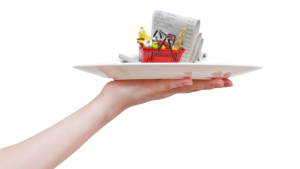One of the unexpected consequences of the pandemic is a new appreciation by consumers for shelf-stable foods and other consumer packaged goods (CPG) products. Colin Stewart, Executive Vice President of Business Intelligence at Acosta, notes, “All industries are feeling its effects, but brands and retailers in the consumer packaged goods industry are among those on the front lines of this fight. With consumer shopping habits fluctuating rapidly, there are new rules of engagement brands and retailers will need to focus on to keep shelves stocked with critical items, and at the same time, keep shoppers and employees safe.”[1] The first impact felt by the CPG industry was panic buying. This trend resulted in consumers faced with empty shelves where toilet paper and hand sanitizer was once displayed. According to IRI, panic buying “appears to have leveled off, although overall dollar spending demand for CPG product departments, categories and formats has increased.”[2]
According to Tricia Ewald, a Managing Partner for marketing and communications at ICF, the CPG industry has stepped up to meet pandemic challenges. The pandemic, she writes, “has given CPG companies a chance to ‘walk the talk.’ … Leading CPG firms … have spent the crisis prioritizing the health and well-being of employees, serving customers who count on their brands, and supporting the communities, agencies, and people on the front lines. … It’s been inspiring to witness how quickly CPG firms … pivoted their manufacturing to develop much-needed equipment such as medical disinfectant, hand sanitizer gels, and face masks.”[3] She adds, “It’s also likely to be good for business in the long term.”
Impacts of the pandemic on the CPG industry
Ewald notes many of the items consumers stockpiled during the panic-buying phase of the pandemic were found in the center aisles of grocery stores. Center-aisle products, she observes, “have been fading in relevance for decades. But the need for familiar, affordable, and shelf-stable products bucked that trend, at least for the time being.” As a result, “Leading CPG companies and their retailer partners responded to the pandemic-induced demand surge by ramping up production of these in-demand products and limiting purchases during a single visit. The result? Products and brands that have been largely afterthoughts are enjoying an elevated status and fresh relevance — provided they can manage to stay available through whatever disruption lies ahead.” According to P.J. Bednarski (@pjbtweet), when panic buying set in, consumers looked for familiar brands. He reports, “When the consumer buying frenzy began, consumers gravitated toward the products they know best. As things have slowed a bit, those brands are now in an even stronger position.”[4]
Consumers confronted with emptying shelves did look to buy alternative products when their favorite brands were out of stock. As a result, Stewart notes, “One of the most important steps retailers should take is ensuring the most in-demand preventative and pantry-loading items, like hand sanitizer, paper products and bottled water, remain available on shelves.” To make that happen, he explains, retailers and manufacturers need to collaborate even more closely than they have in the past. “For manufacturers,” he writes, “the chief focus should be on production of core items to keep up with demand. To supplement those incremental production needs, they may need to hire seasonal staff. Manufacturers should provide solutions to help stores maintain their inventory of key preventative and pantry-loading items with pallet quantities and direct ship options. Collaboration between retailers and manufacturers is essential during these changing times. They should stack hands to drive shelf stock for their customers, and manufacturers should proactively schedule virtual communications with their retailers to support supply chain and product sourcing.”
Analytics and the way ahead
No one knows for certain how the future will unfold. Nevertheless, Anil Kaul (@anil_kaul), co-founder and CEO of Absolutdata, insists, “Consumer packaged goods companies who use artificial intelligence are finding a shortcut to the new normal.”[5] To get to the “new normal,” Kaul suggests CPG firms need to answer two questions: “What will consumer behavior and profiles look like in the new normal? What will the demand pattern look like going forward?” He adds, “To put it another way, you need to know what people will buy, where they will buy it, how they’ll buy, what quantities they’ll buy and how often they’ll buy. Prior to the pandemic, historical data provided some guidance. Now, all that manufacturing, logistics, pricing, customer engagement and general commerce data is obsolete.” At Enterra Solutions® we found ourselves supporting clients faced with just such a dilemma. As a result, we found new ways to combine and analyze data in the Enterra Global Insights and Optimization System™ to help find answers to the questions Kaul poses. As Kaul notes, “CPGs are building AI models to help them predict general demand curves. AI can evaluate multiple data sources, such as internal company data and publicly available information like anonymized mobile or text data. That way, it can predict when significant changes are imminent, such as accelerating or decelerating movement in regional infection rates that might trigger a shutdown or a reopening that could affect supply chains, production or demand.”
Scott McKenzie (@mckenziescott), a Nielsen Intelligence Leader, suggests there will be three distinct time horizons for global market regeneration following the pandemic. They are:
• Rebound: “An early return to normal living conditions (schools, workplaces, stores, restaurants, etc., re-open) at some point in the third quarter of 2020.”
• Reboot: “A medium-term scenario that is positioned in the fourth quarter of the year.”
• Reinvent: “A longer-term view that places the world in a general return to normal living conditions at some point in the first half of 2021.”
McKenzie’s timelines may be off (i.e., a bit optimistic), but he is correct about the general trajectory of the recovery. AI can help determine when each phase is commencing. Just as importantly, AI can help determine how consumer demand is changing during each phase. McKenzie notes, “Pack sizes, brand choices, product origins and more will be reconfigured as shoppers adjust to changed economic circumstances and a sharper focus on their health and safety.” Kaul reports cognitive systems have already provided some insights. He writes, “AI has already discovered a number of trends to help CPGs plan their next move, including consumers’ ‘cocooning’ behavior, which appears to have some staying power beyond initial lockdown periods. AI saw early on that people waiting out the pandemic in their homes were moving to digital-first buying habits, ordering items as varied as food, luxury goods and fashion online. Another trend AI caught early is a new focus on frugality and quality in buying behavior. While an emphasis on frugality could be extrapolated from pervasive economic uncertainty, a consumer focus on high-quality experiences when dining out and spending on goods and services wasn’t something most human analysts saw coming. But AI was able to detect signals and provide insight.”
Concluding thoughts
Sara White concludes, “CEOs of successful consumer packaged goods companies know they need to make clear-cut decisions in order to be true business leaders. One poor decision can be disastrous. As far as the CPG industry is concerned, employing a data-backed business strategy is crucial for success where there is minimal scope for wrong decisions. There can be no substitute for a data-driven, well-informed, business decision-making.”[7] Kaul adds, “Decision makers need fast access to data to get answers on changing consumer behavior as well as evolving demand patterns and emerging facts on the ground that may affect business. No one knows exactly when things will feel ‘normal’ again, but CPGs that have turned to AI for answers have found a shortcut to the new normal we live in now.”
Footnotes
[1] Colin Stewart, “The Impact of Coronavirus on CPG Brands,” Total Retail, 1 April 2020.
[2] Thad Rueter, “IRI Offers Closer View of CPG Pandemic Trends,” Retail Leader, 28 April 2020.
[3] Tricia Ewald, “The post-pandemic opportunity for the consumer packaged goods (CPG) industry, ” ICF Insights, 8 May 2020.
[4] P.J. Bednarski, “Established CPG Brands Have Even Stronger Pandemic Sales,” MediaPost, 15 May 2020.
[5] Anil Kaul, “Using AI as a Shortcut to the New Normal,” Path to Purchase IQ, 30 June 2020.
[6] Michael Browne, “‘Rebound, Reboot, Reinvent’: What retail and CPG companies can expect in a post-coronavirus world,” Supermarket News, 8 May 2020.
[7] Sara White, “Data Analytics For Your CPG Company,” Supplypike Blog, 2 July 2020.





